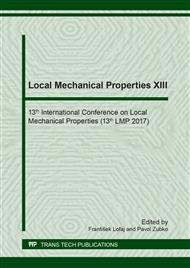p.3
p.9
p.15
p.21
p.27
p.33
p.38
p.44
Microstructure and Local Mechanical Properties of Skutterudites with Addition of Metallic Borides
Abstract:
Skutterudites are an important class of thermoelectric p- and n-type materials and they have already achieved fair efficiencies for the conversion of heat to electricity. Nevertheless researchers try to further enhance the figure of merit, ZT, by various ways. In this work we study microstructure and mechanical properties of two thermoelectric materials: an industrial n-type (Mm,Sm)yCo4Sb12 skutterudite and an industrial p-type DDyFe3CoSb12 skutterudite, both mixed with 1 wt.% of Ta0.8Zr0.2B. Thin lamellae were prepared from the compacted materials using a focused ion beam. Analytical transmission electron microscopy was used on lamellae to study details of microstructure. A fine dispersion of precipitates was found both at nanograin boundaries and in their interiors. Quasistatic and dynamic nanoindentation tests were carried out on planar polished sections in the range of applied loads from 0.01 to 10 mN. The results were complemented with quantitative modulus mapping of local mechanical properties with 10-nm resolution.
Info:
Periodical:
Pages:
9-14
Citation:
Online since:
October 2018
Authors:
Keywords:
Price:
Сopyright:
© 2018 Trans Tech Publications Ltd. All Rights Reserved
Share:
Citation:


